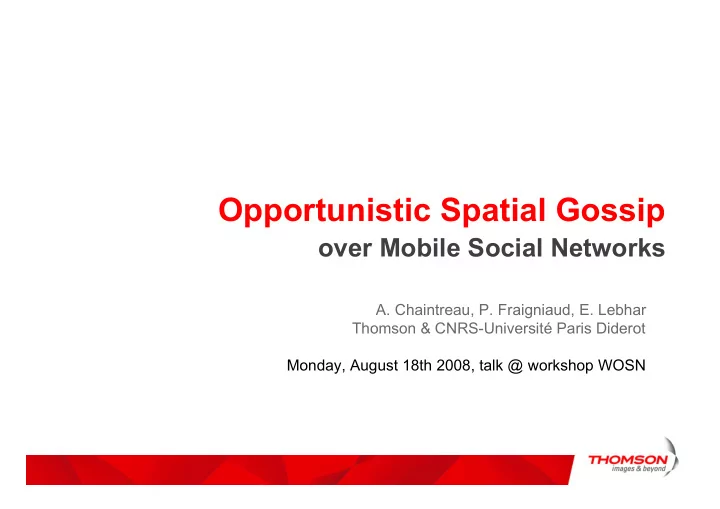

Opportunistic Spatial Gossip over Mobile Social Networks A. Chaintreau, P. Fraigniaud, E. Lebhar Thomson & CNRS-Université Paris Diderot Monday, August 18th 2008, talk @ workshop WOSN
Objectives of this talk Discuss the future of Social Networks Applications – emphasis on mobile users and peer to peer architecture Present one main result: – Mobility helps maintaining favorable structural properties 3
Structure of this talk Mobile social network applications Model and opportunistic connection scheme Application to resource location Concluding remarks 4
In a near future … Most users may access OSNs (and the Internet) through a mobile devices Their respective locations become relevant – “who is my closest friend and where he/she is?” – “what is the closest event happening?” Bandwidth: – Infrastructure may exist and perhaps remains expensive – Opportunistic contacts with users and APs explode 5
Challenges: the role of mobility Is mobility only a troublemaker? Can it be helpful? – may increase ad-hoc capacity [Grossglauser/Tse 01] – Can random mobility induces favorable structural properties ? As an example, can mobility facilitate Navigation? – Add a small number of links, used by routing incidentally such that O(polylog d) steps ? [Kleinberg00]. 6
Structure of this talk Mobile social network applications Model and opportunistic connection scheme Application to resource location Concluding remarks 7
Our network assumptions Nodes are located on a lattice (dimension k) – Static: fixed access points – Mobile: mutually independent random walks Opportunistic connections – Each static/mobile node has a small number of mates, chosen as nodes that are met opportunistically. – A node may contact any of its mate later – A mate with age is forgotten with probability e.g. such that the age distribution of a mate is 8
Why such opportunistic scheme for OSNs? (Physicist): – Understand mobile social networks. – Simple ageing scheme. (Computer scientist): – easy to enforce as a p2p augmentation scheme (Economist): – Can be done inside community of interest 9
Structure of this talk Mobile Social Network Applications Model and Opportunistic connection scheme Application to resource location Concluding remarks 10
Key building block Navigation [Kleinberg00] , Spatial gossip [Kempe-Kleinberg- Demers01] exploits specific random shorcuts – For any , shortcuts length distribution as For any , there exists a forget function such that the shortcuts length distribution satisfies – Proof follows from properties of symmetric random walks – It corresponds to 11
Application to Resource location The goal is to locate the nearest item – a copy of a file, or a node with a given property. With this scheme, gossiping with mates finds the item using steps ( is the distance to the nearest item). 12
Concluding remarks Social Network Applications can exploit mobility – To answer efficiently locality aware query. – Key result: benefit from favorable augmentation topology Future steps: – Gossiping with mates among mobile nodes only – How different mobility affects the forgetting distribution? – Can we use the same property without infrastructure? 13
Thank you!
Recommend
More recommend